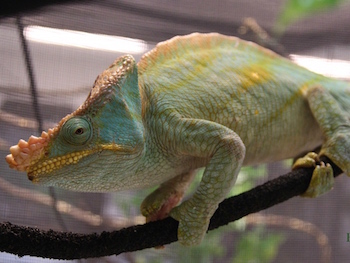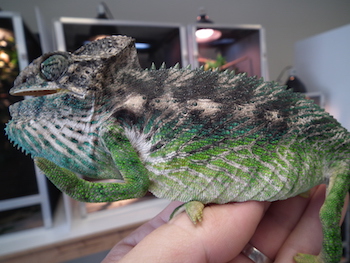A list of the world's largest chameleons
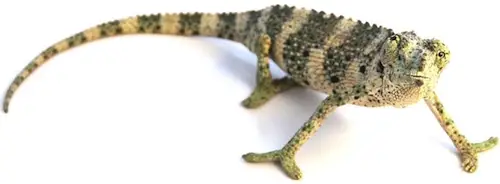
The Largest Chameleons
What’s the largest chameleon in the world?
If you’re like most people, you’ve never seen the surprisingly large size some chameleons can attain. Below I’ll show you what I consider to be the biggest chameleon species in the world, as well as a few very worthy honorable mentions.
It’s worth noting that the terms “biggest” and “largest” are relative when describing chameleons. The reason is that the longest species is not necessarily also the heaviest species. There’s much debate about the subject. Regardless, when it comes to sheer mass and overall size, I believe there’s only one chameleon that deservedly wears the crown of “Largest chameleon in the world.”
If you’re like most people, you’ve never seen the surprisingly large size some chameleons can attain. Below I’ll show you what I consider to be the biggest chameleon species in the world, as well as a few very worthy honorable mentions.
It’s worth noting that the terms “biggest” and “largest” are relative when describing chameleons. The reason is that the longest species is not necessarily also the heaviest species. There’s much debate about the subject. Regardless, when it comes to sheer mass and overall size, I believe there’s only one chameleon that deservedly wears the crown of “Largest chameleon in the world.”
Parson’s Chameleon (Calumma parsonii)
The King Kong of the chameleon world. Nothing can match the mass and bulk of a Parson’s chameleon—they are indeed the logical choice for largest chameleon species in the world. I’ve added a few pictures of some yellow-lip Parson’s chameleons of mine so that you can fully appreciate their overall size.
In the first picture, you can see the male’s tail isn’t even close to ending at the bottom of the photograph. In the second, you can see my hand (I’m a 200lb adult male) for added scale. Again, the giant chameleon’s tail extends well below the bottom of the picture.
It’s often said that they can reach the size of a small house cat, and I can attest that it’s an accurate comparison. Officially, it’s believed Parson’s chameleons can reach a total length of 26-28 inches.
Males definitely get larger than females, and the one in the first two pictures is about 24 inches or so. Males also develop really unique, jagged rostral horns, but females do not.
The King Kong of the chameleon world. Nothing can match the mass and bulk of a Parson’s chameleon—they are indeed the logical choice for largest chameleon species in the world. I’ve added a few pictures of some yellow-lip Parson’s chameleons of mine so that you can fully appreciate their overall size.
In the first picture, you can see the male’s tail isn’t even close to ending at the bottom of the photograph. In the second, you can see my hand (I’m a 200lb adult male) for added scale. Again, the giant chameleon’s tail extends well below the bottom of the picture.
It’s often said that they can reach the size of a small house cat, and I can attest that it’s an accurate comparison. Officially, it’s believed Parson’s chameleons can reach a total length of 26-28 inches.
Males definitely get larger than females, and the one in the first two pictures is about 24 inches or so. Males also develop really unique, jagged rostral horns, but females do not.
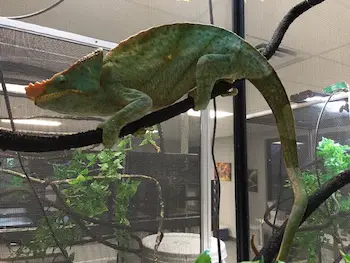
Size: 26-28 inches (66-71 cm)
Weight: 1.5lbs - 2lbs
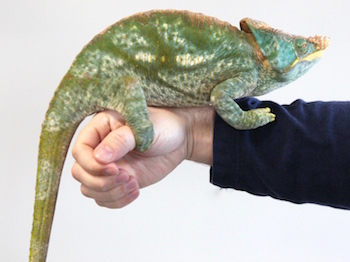
Demeanor: Calm
Lifespan: 20+ years
The forests of Madagascar are where these giant chameleons hail from, although they’ve only recently opened up export quotas once again, after a long hiatus. It’s my hope that this is because their numbers in the wild are considered stable.
Captive bred Parson’s chameleons are very rare, but I don’t think it’s because it’s overly difficult to get them to mate. I postulate that it’s because they’re rarely seen in the reptile hobby, they’re exorbitantly expensive when they are available, and the eggs are considered difficult to incubate since they must undergo a type of hibernation period called “diapause,” and it can take up to two years for them to hatch. That’s a big commitment on a number of levels.
Fairly recently I was fortunate enough to get a large, robust female Yellow-lip Parson’s chameleon, through legal importation from Madagascar. She seemed very plump, and I of course had high hopes she was gravid. Fast forward a few weeks, and she laid 68 beautiful, fertile eggs for me. I purchased an expensive incubator so that I could bring the eggs through defined temperature cycles. The eggs about eight months into incubation and they’re looking good, so we’ll see.
This sharp-looking male is a new arrival. Export quotas are now being produced by the country of Madagascar after a long period where exportation was completely disallowed.
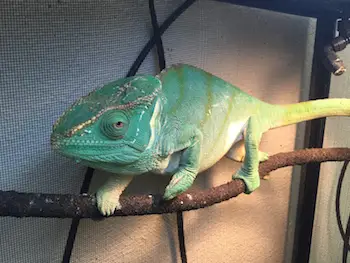
Here’s a female Yellow-lip Parson’s chameleon shortly after she laid 68 fertile eggs for me. She’s still doing very well to this day, many months later. Hornworms are her absolute favorite food.
I feed these huge chameleons large crickets, hornworms, and roaches. They can eat a lot of food, but they’re not what I’d call aggressive eaters—they’re more focused and deliberate. They require a tremendous amount of water—more than any chameleon I’ve ever kept. The large female that laid eggs for me drinks from a drip for several minutes every single day.
I’ve never come across an aggressive Parson’s—they seem docile by nature. Their skin is also unlike any other chameleon—it’s soft, almost like velvet. You really have to see it to understand.
Their lifespan can supposedly extend well beyond 20 years, with one hobbyist claiming to have purchased an adult Parson’s chameleon 25 years ago, that is still alive.
In closing, to quote Ferris Bueller, “If you have the means, I highly recommend picking one up.” I was talking with an “old time” chameleon keeper who said Parson’s chameleons used to sell for around $100 each in the 80’s and 90’s. Nowadays, they’re many times more expensive.
You can read some general information about these massive chameleons on the Wikipedia Parson’s chameleon page, and you can also check out a care sheet by Michael Fry.
The largest chameleons: Honorable mentions
I mentioned earlier that the heaviest, most massive chameleon species isn’t necessarily the longest chameleon species as well. So, I think it’s worthwhile to have an honorable mention section for the largest chameleons, because there are some other species besides the Parson’s that are both huge and impressive. Without further ado, let’s dive in.
Meller’s Chameleon (Chamaeleo melleri)
Meller’s are some big chameleons. They are, in my opinion, the second largest species of chameleon in the world. The one pictured is an unusually whitish-colored beast I kept a few months ago before selling it. They’re a heavy-bodied species with a tall dorsal crest.
One defining characteristic is their rostral “nose” horn. Often times this horn is bent or missing from imported specimens, and it doesn’t grow back. It’s actually unusual to find one intact.
They’re named after a botanist from the 1800’s, and are the largest of the mainland African chameleons. In other words, the largest chameleons on the content of Africa, with the exception of Madagascar which lies off the coast of Mozambique. They’re also known as “Bird-eating” chameleons, which gives you an idea of the large size of this species.
It’s believed that Meller’s chameleons can reach 30 inches in length, and I can say from personal experience that they’re a very robust chameleon, not just lengthy.
Really an impressive species, and beautifully colored, with greens, yellows, black, and white. They can actually be kept in groups, unlike most chameleons.
Meller’s are some big chameleons. They are, in my opinion, the second largest species of chameleon in the world. The one pictured is an unusually whitish-colored beast I kept a few months ago before selling it. They’re a heavy-bodied species with a tall dorsal crest.
One defining characteristic is their rostral “nose” horn. Often times this horn is bent or missing from imported specimens, and it doesn’t grow back. It’s actually unusual to find one intact.
They’re named after a botanist from the 1800’s, and are the largest of the mainland African chameleons. In other words, the largest chameleons on the content of Africa, with the exception of Madagascar which lies off the coast of Mozambique. They’re also known as “Bird-eating” chameleons, which gives you an idea of the large size of this species.
It’s believed that Meller’s chameleons can reach 30 inches in length, and I can say from personal experience that they’re a very robust chameleon, not just lengthy.
Really an impressive species, and beautifully colored, with greens, yellows, black, and white. They can actually be kept in groups, unlike most chameleons.
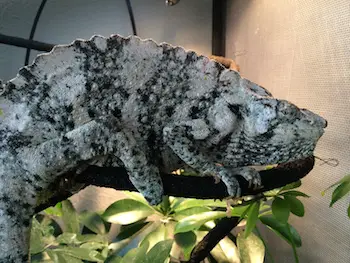
Size: 24-30 inches (61-76 cm)
Weight: 1.0lbs - 1.5lbs
Demeanor: Aggressive
Lifespan: 8+ years
It’s said that they’ll lay up to 80 eggs at a time, which is incredible if it’s true. Unfortunately, they’re very, very rarely bred in captivity. Even gravid imports seem rare. Although I’ve never deliberately tried to breed them, I’ve kept hundreds of them for short periods and have never had one lay eggs. I don’t recall any customers responding with an egg report either.
Meller’s chameleons tend to be on the aggressive side. While I’ve never been bit by one, they’ve attempted to bite many times. It’s just that chameleons are usually so slow it’s totally avoidable.
Their big claws tend to be strong and can definitely draw blood, much like the Parson’s chameleons.
You can read some very general information about these giant chameleons on the National Geographic Meller’s chameleon page. If you’d like more information on how to care for this species, check out the care sheet by Reptiles Magazine.
Oustalet’s Chameleon (Furcifer oustaleti)
No list of the largest chameleons in the world would be complete without mentioning the Oustalet’s. This species hails from very dry areas in Madagascar, which is why they tend to be one of the tougher species in captivity, in that they don’t require as much water as other more tropical species.
Pictured to the left is my biggest breeder male Oustalet’s chameleon, who has fathered many clutches for me. He’s a massive, docile beast, over 20-inches long and very heavy-bodied.
They grow quickly, and can easily reach 18-inches in length within the first year. Named after a French biologist named Jean-Frederic Emile Oustalet’s, pronounced “oo—stuh—lays.”
Outset’s aren’t considered a species of concern, which means their wild populations are large and doing well.
No list of the largest chameleons in the world would be complete without mentioning the Oustalet’s. This species hails from very dry areas in Madagascar, which is why they tend to be one of the tougher species in captivity, in that they don’t require as much water as other more tropical species.
Pictured to the left is my biggest breeder male Oustalet’s chameleon, who has fathered many clutches for me. He’s a massive, docile beast, over 20-inches long and very heavy-bodied.
They grow quickly, and can easily reach 18-inches in length within the first year. Named after a French biologist named Jean-Frederic Emile Oustalet’s, pronounced “oo—stuh—lays.”
Outset’s aren’t considered a species of concern, which means their wild populations are large and doing well.
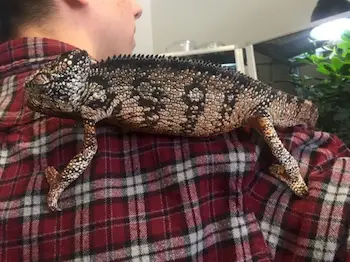
Size: 22-28 inches (61-71 cm)
Weight: 1.0lbs - 1.5lbs
Demeanor: Moderate
Lifespan: 8+ years
They’re big eaters, and I’ve mentioned previously that my big adult female Oustalet’s chameleon is the single best eater I have—she attacks prey items with a vengeance.
This giant species can consume a vast amount of feeder insects in one session. I feed mine crickets primarily, with occasional roaches and hornworms thrown in for variety.
Interestingly, I was able to cross-breed my female Oustalet’s with my biggest breeder male Panther chameleon. The 30 eggs were laid, and the babies emerged almost eight months later at a 100% hatch rate. Out of 30 babies, only one perished. This is a strong species.
I review this species as one of the best pet chameleons as well, for a variety of reasons. Definitely one of my absolutely favorite chameleons—the fact that they attain a very large size is just a bonus.
Giant Spiny Chameleon (Furcifer verrucosus)
Giant spiny chameleons get big, but they’re not massive like some of the above chameleons. They can still hit 22-23 inches, which is no doubt large, but they’re just not as bulky or heavy.
They’ve got unusually tall dorsal spikes, thus their namesake, and their head casques are taller than their Oustalet’s cousins. It’s believed that the two species can inter-breed, and do so in the wild.
Giant spiny chameleons get big, but they’re not massive like some of the above chameleons. They can still hit 22-23 inches, which is no doubt large, but they’re just not as bulky or heavy.
They’ve got unusually tall dorsal spikes, thus their namesake, and their head casques are taller than their Oustalet’s cousins. It’s believed that the two species can inter-breed, and do so in the wild.
Size: 20-23 inches (51-58 cm)
Weight: 1.0lbs - 1.25lbs
Demeanor: Moderate
Lifespan: 5+ years
The male pictured above was one of the first Giant spiny chameleons I imported. He was feisty and a great eater. Notice the beautiful green and blue coloration.
Their eggs incubate well, as I’ve experienced 100% hatch rates repeatedly. They breed fairly easily and regularly as well. The males attain a large size, but the females are considerably smaller.
These chameleons occur in dry areas of Madagascar (are you noticing a pattern involving Madagascar?), and aren’t as hydration-sensitive as many other chameleons.
